Junwei Su
A Non-Asymptotic Convergent Analysis for Scored-Based Graph Generative Model via a System of Stochastic Differential Equations
Aug 20, 2025Abstract:Score-based graph generative models (SGGMs) have proven effective in critical applications such as drug discovery and protein synthesis. However, their theoretical behavior, particularly regarding convergence, remains underexplored. Unlike common score-based generative models (SGMs), which are governed by a single stochastic differential equation (SDE), SGGMs involve a system of coupled SDEs. In SGGMs, the graph structure and node features are governed by separate but interdependent SDEs. This distinction makes existing convergence analyses from SGMs inapplicable for SGGMs. In this work, we present the first non-asymptotic convergence analysis for SGGMs, focusing on the convergence bound (the risk of generative error) across three key graph generation paradigms: (1) feature generation with a fixed graph structure, (2) graph structure generation with fixed node features, and (3) joint generation of both graph structure and node features. Our analysis reveals several unique factors specific to SGGMs (e.g., the topological properties of the graph structure) which affect the convergence bound. Additionally, we offer theoretical insights into the selection of hyperparameters (e.g., sampling steps and diffusion length) and advocate for techniques like normalization to improve convergence. To validate our theoretical findings, we conduct a controlled empirical study using synthetic graph models, and the results align with our theoretical predictions. This work deepens the theoretical understanding of SGGMs, demonstrates their applicability in critical domains, and provides practical guidance for designing effective models.
On the Interplay between Graph Structure and Learning Algorithms in Graph Neural Networks
Aug 20, 2025Abstract:This paper studies the interplay between learning algorithms and graph structure for graph neural networks (GNNs). Existing theoretical studies on the learning dynamics of GNNs primarily focus on the convergence rates of learning algorithms under the interpolation regime (noise-free) and offer only a crude connection between these dynamics and the actual graph structure (e.g., maximum degree). This paper aims to bridge this gap by investigating the excessive risk (generalization performance) of learning algorithms in GNNs within the generalization regime (with noise). Specifically, we extend the conventional settings from the learning theory literature to the context of GNNs and examine how graph structure influences the performance of learning algorithms such as stochastic gradient descent (SGD) and Ridge regression. Our study makes several key contributions toward understanding the interplay between graph structure and learning in GNNs. First, we derive the excess risk profiles of SGD and Ridge regression in GNNs and connect these profiles to the graph structure through spectral graph theory. With this established framework, we further explore how different graph structures (regular vs. power-law) impact the performance of these algorithms through comparative analysis. Additionally, we extend our analysis to multi-layer linear GNNs, revealing an increasing non-isotropic effect on the excess risk profile, thereby offering new insights into the over-smoothing issue in GNNs from the perspective of learning algorithms. Our empirical results align with our theoretical predictions, \emph{collectively showcasing a coupling relation among graph structure, GNNs and learning algorithms, and providing insights on GNN algorithm design and selection in practice.}
SBGD: Improving Graph Diffusion Generative Model via Stochastic Block Diffusion
Aug 20, 2025Abstract:Graph diffusion generative models (GDGMs) have emerged as powerful tools for generating high-quality graphs. However, their broader adoption faces challenges in \emph{scalability and size generalization}. GDGMs struggle to scale to large graphs due to their high memory requirements, as they typically operate in the full graph space, requiring the entire graph to be stored in memory during training and inference. This constraint limits their feasibility for large-scale real-world graphs. GDGMs also exhibit poor size generalization, with limited ability to generate graphs of sizes different from those in the training data, restricting their adaptability across diverse applications. To address these challenges, we propose the stochastic block graph diffusion (SBGD) model, which refines graph representations into a block graph space. This space incorporates structural priors based on real-world graph patterns, significantly reducing memory complexity and enabling scalability to large graphs. The block representation also improves size generalization by capturing fundamental graph structures. Empirical results show that SBGD achieves significant memory improvements (up to 6$\times$) while maintaining comparable or even superior graph generation performance relative to state-of-the-art methods. Furthermore, experiments demonstrate that SBGD better generalizes to unseen graph sizes. The significance of SBGD extends beyond being a scalable and effective GDGM; it also exemplifies the principle of modularization in generative modeling, offering a new avenue for exploring generative models by decomposing complex tasks into more manageable components.
Knowledge Augmented Complex Problem Solving with Large Language Models: A Survey
May 06, 2025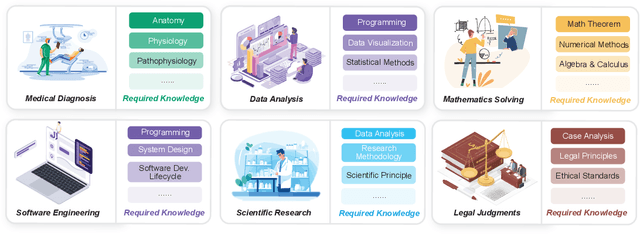
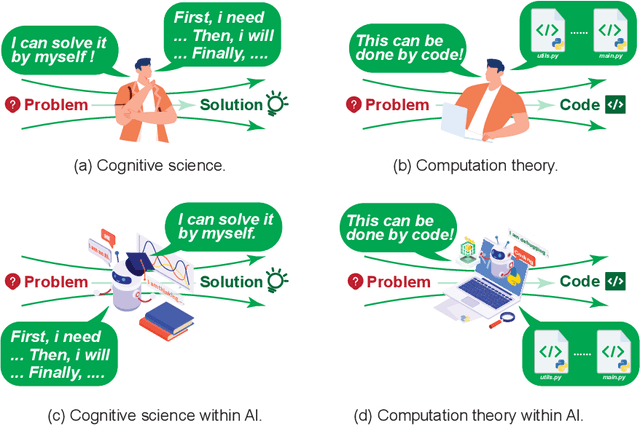
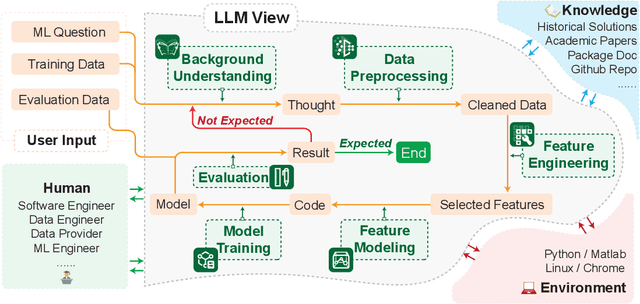

Abstract:Problem-solving has been a fundamental driver of human progress in numerous domains. With advancements in artificial intelligence, Large Language Models (LLMs) have emerged as powerful tools capable of tackling complex problems across diverse domains. Unlike traditional computational systems, LLMs combine raw computational power with an approximation of human reasoning, allowing them to generate solutions, make inferences, and even leverage external computational tools. However, applying LLMs to real-world problem-solving presents significant challenges, including multi-step reasoning, domain knowledge integration, and result verification. This survey explores the capabilities and limitations of LLMs in complex problem-solving, examining techniques including Chain-of-Thought (CoT) reasoning, knowledge augmentation, and various LLM-based and tool-based verification techniques. Additionally, we highlight domain-specific challenges in various domains, such as software engineering, mathematical reasoning and proving, data analysis and modeling, and scientific research. The paper further discusses the fundamental limitations of the current LLM solutions and the future directions of LLM-based complex problems solving from the perspective of multi-step reasoning, domain knowledge integration and result verification.
Temporal-Aware Evaluation and Learning for Temporal Graph Neural Networks
Dec 10, 2024Abstract:Temporal Graph Neural Networks (TGNNs) are a family of graph neural networks designed to model and learn dynamic information from temporal graphs. Given their substantial empirical success, there is an escalating interest in TGNNs within the research community. However, the majority of these efforts have been channelled towards algorithm and system design, with the evaluation metrics receiving comparatively less attention. Effective evaluation metrics are crucial for providing detailed performance insights, particularly in the temporal domain. This paper investigates the commonly used evaluation metrics for TGNNs and illustrates the failure mechanisms of these metrics in capturing essential temporal structures in the predictive behaviour of TGNNs. We provide a mathematical formulation of existing performance metrics and utilize an instance-based study to underscore their inadequacies in identifying volatility clustering (the occurrence of emerging errors within a brief interval). This phenomenon has profound implications for both algorithm and system design in the temporal domain. To address this deficiency, we introduce a new volatility-aware evaluation metric (termed volatility cluster statistics), designed for a more refined analysis of model temporal performance. Additionally, we demonstrate how this metric can serve as a temporal-volatility-aware training objective to alleviate the clustering of temporal errors. Through comprehensive experiments on various TGNN models, we validate our analysis and the proposed approach. The empirical results offer revealing insights: 1) existing TGNNs are prone to making errors with volatility clustering, and 2) TGNNs with different mechanisms to capture temporal information exhibit distinct volatility clustering patterns. Our empirical findings demonstrate that our proposed training objective effectively reduces volatility clusters in error.
Improving Implicit Regularization of SGD with Preconditioning for Least Square Problems
Mar 29, 2024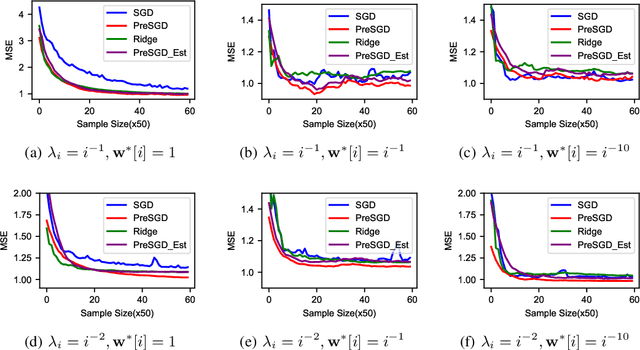
Abstract:Stochastic gradient descent (SGD) exhibits strong algorithmic regularization effects in practice and plays an important role in the generalization of modern machine learning. However, prior research has revealed instances where the generalization performance of SGD is worse than ridge regression due to uneven optimization along different dimensions. Preconditioning offers a natural solution to this issue by rebalancing optimization across different directions. Yet, the extent to which preconditioning can enhance the generalization performance of SGD and whether it can bridge the existing gap with ridge regression remains uncertain. In this paper, we study the generalization performance of SGD with preconditioning for the least squared problem. We make a comprehensive comparison between preconditioned SGD and (standard \& preconditioned) ridge regression. Our study makes several key contributions toward understanding and improving SGD with preconditioning. First, we establish excess risk bounds (generalization performance) for preconditioned SGD and ridge regression under an arbitrary preconditions matrix. Second, leveraging the excessive risk characterization of preconditioned SGD and ridge regression, we show that (through construction) there exists a simple preconditioned matrix that can outperform (standard \& preconditioned) ridge regression. Finally, we show that our proposed preconditioning matrix is straightforward enough to allow robust estimation from finite samples while maintaining a theoretical advantage over ridge regression. Our empirical results align with our theoretical findings, collectively showcasing the enhanced regularization effect of preconditioned SGD.
BG-HGNN: Toward Scalable and Efficient Heterogeneous Graph Neural Network
Mar 13, 2024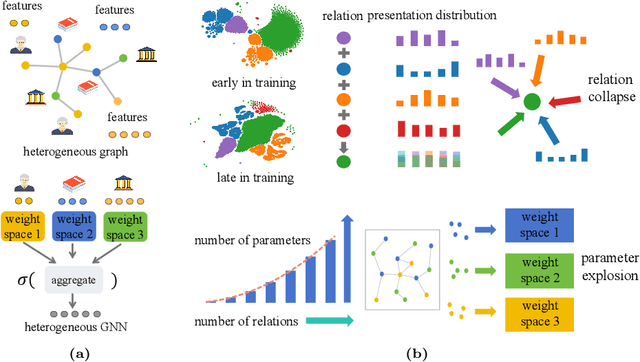
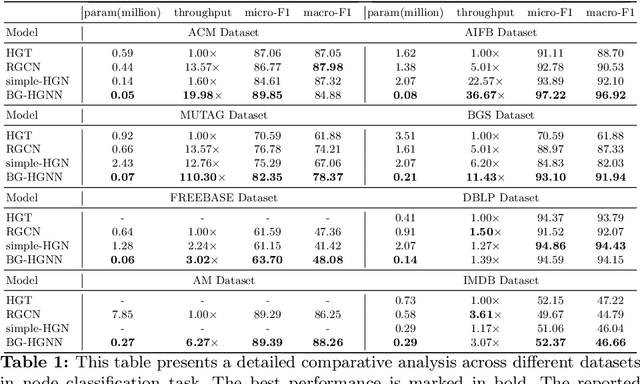
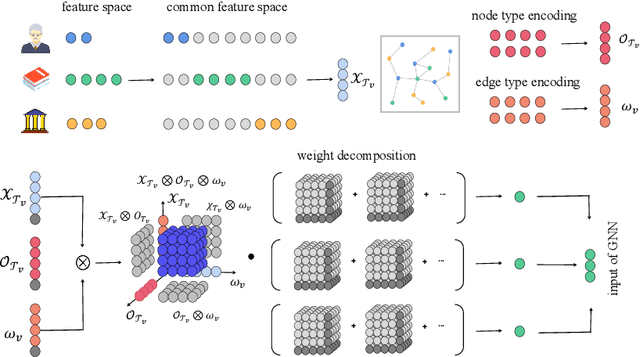
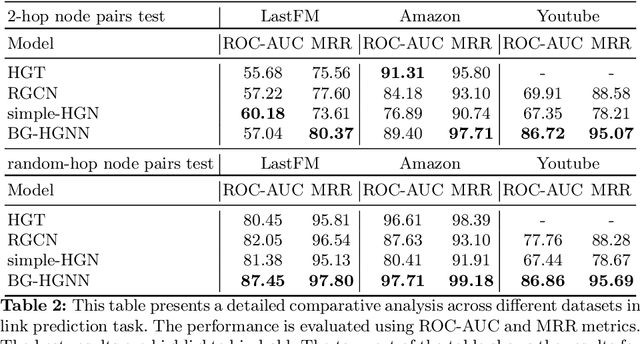
Abstract:Many computer vision and machine learning problems are modelled as learning tasks on heterogeneous graphs, featuring a wide array of relations from diverse types of nodes and edges. Heterogeneous graph neural networks (HGNNs) stand out as a promising neural model class designed for heterogeneous graphs. Built on traditional GNNs, existing HGNNs employ different parameter spaces to model the varied relationships. However, the practical effectiveness of existing HGNNs is often limited to simple heterogeneous graphs with few relation types. This paper first highlights and demonstrates that the standard approach employed by existing HGNNs inevitably leads to parameter explosion and relation collapse, making HGNNs less effective or impractical for complex heterogeneous graphs with numerous relation types. To overcome this issue, we introduce a novel framework, Blend&Grind-HGNN (BG-HGNN), which effectively tackles the challenges by carefully integrating different relations into a unified feature space manageable by a single set of parameters. This results in a refined HGNN method that is more efficient and effective in learning from heterogeneous graphs, especially when the number of relations grows. Our empirical studies illustrate that BG-HGNN significantly surpasses existing HGNNs in terms of parameter efficiency (up to 28.96 $\times$), training throughput (up to 8.12 $\times$), and accuracy (up to 1.07 $\times$).
On the Topology Awareness and Generalization Performance of Graph Neural Networks
Mar 07, 2024Abstract:Many computer vision and machine learning problems are modelled as learning tasks on graphs, where graph neural networks (GNNs) have emerged as a dominant tool for learning representations of graph-structured data. A key feature of GNNs is their use of graph structures as input, enabling them to exploit the graphs' inherent topological properties-known as the topology awareness of GNNs. Despite the empirical successes of GNNs, the influence of topology awareness on generalization performance remains unexplored, particularly for node-level tasks that diverge from the assumption of data being independent and identically distributed (I.I.D.). The precise definition and characterization of the topology awareness of GNNs, especially concerning different topological features, are still unclear. This paper introduces a comprehensive framework to characterize the topology awareness of GNNs across any topological feature. Using this framework, we investigate the effects of topology awareness on GNN generalization performance. Contrary to the prevailing belief that enhancing the topology awareness of GNNs is always advantageous, our analysis reveals a critical insight: improving the topology awareness of GNNs may inadvertently lead to unfair generalization across structural groups, which might not be desired in some scenarios. Additionally, we conduct a case study using the intrinsic graph metric, the shortest path distance, on various benchmark datasets. The empirical results of this case study confirm our theoretical insights. Moreover, we demonstrate the practical applicability of our framework by using it to tackle the cold start problem in graph active learning.
MSPipe: Efficient Temporal GNN Training via Staleness-aware Pipeline
Feb 23, 2024

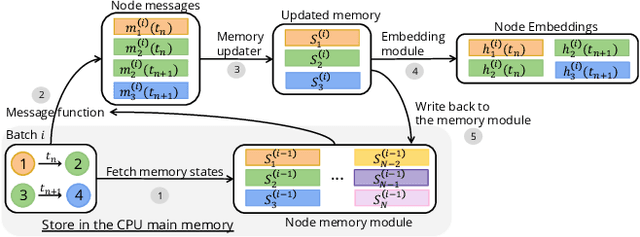

Abstract:Memory-based Temporal Graph Neural Networks (MTGNNs) are a class of temporal graph neural networks that utilize a node memory module to capture and retain long-term temporal dependencies, leading to superior performance compared to memory-less counterparts. However, the iterative reading and updating process of the memory module in MTGNNs to obtain up-to-date information needs to follow the temporal dependencies. This introduces significant overhead and limits training throughput. Existing optimizations for static GNNs are not directly applicable to MTGNNs due to differences in training paradigm, model architecture, and the absence of a memory module. Moreover, they do not effectively address the challenges posed by temporal dependencies, making them ineffective for MTGNN training. In this paper, we propose MSPipe, a general and efficient framework for MTGNNs that maximizes training throughput while maintaining model accuracy. Our design addresses the unique challenges associated with fetching and updating node memory states in MTGNNs by integrating staleness into the memory module. However, simply introducing a predefined staleness bound in the memory module to break temporal dependencies may lead to suboptimal performance and lack of generalizability across different models and datasets. To solve this, we introduce an online pipeline scheduling algorithm in MSPipe that strategically breaks temporal dependencies with minimal staleness and delays memory fetching to obtain fresher memory states. Moreover, we design a staleness mitigation mechanism to enhance training convergence and model accuracy. We provide convergence analysis and prove that MSPipe maintains the same convergence rate as vanilla sample-based GNN training. Experimental results show that MSPipe achieves up to 2.45x speed-up without sacrificing accuracy, making it a promising solution for efficient MTGNN training.
Towards Robust Graph Incremental Learning on Evolving Graphs
Feb 20, 2024



Abstract:Incremental learning is a machine learning approach that involves training a model on a sequence of tasks, rather than all tasks at once. This ability to learn incrementally from a stream of tasks is crucial for many real-world applications. However, incremental learning is a challenging problem on graph-structured data, as many graph-related problems involve prediction tasks for each individual node, known as Node-wise Graph Incremental Learning (NGIL). This introduces non-independent and non-identically distributed characteristics in the sample data generation process, making it difficult to maintain the performance of the model as new tasks are added. In this paper, we focus on the inductive NGIL problem, which accounts for the evolution of graph structure (structural shift) induced by emerging tasks. We provide a formal formulation and analysis of the problem, and propose a novel regularization-based technique called Structural-Shift-Risk-Mitigation (SSRM) to mitigate the impact of the structural shift on catastrophic forgetting of the inductive NGIL problem. We show that the structural shift can lead to a shift in the input distribution for the existing tasks, and further lead to an increased risk of catastrophic forgetting. Through comprehensive empirical studies with several benchmark datasets, we demonstrate that our proposed method, Structural-Shift-Risk-Mitigation (SSRM), is flexible and easy to adapt to improve the performance of state-of-the-art GNN incremental learning frameworks in the inductive setting.
 Add to Chrome
Add to Chrome Add to Firefox
Add to Firefox Add to Edge
Add to Edge